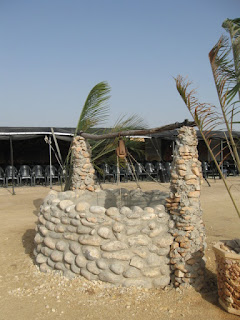Our first stop was at the camel farm near the bedouin village Tarabin. The sole objective of this farm is the production of camel milk. It is believed (on the basis of long, thorough research) that the composition of this milk is closest to that of human mother milk, hence its miraculous properties. It can combat almost any known health issue and inflammation.
The camel Abraham at the entrance to the farm
round water well near the camel
too scared to go closer to the camel
chairs and tables for a bite and a drink
several tents like this one with chairs for visitors attending lectures
.
toilets; a round pool of water nearby
Upon arrival, three bedouin workers offered us tiny cups of traditional black coffee/tea, prepared on three pots on a stove behind them. On their left - the products' selling tent: food and cosmetics.
bedouin workers offering coffee/tea to visitors; see the pots
food section: among other food items, desserts for 15 shekel each:
malabi(milk pudding), kadaif (turkish dessert),milk jam, cheese cake
malabi(milk pudding), kadaif (turkish dessert),milk jam, cheese cake
fridge with cold drinks
A young bedouin woman was standing by a stove,making thin pita bread by stretching the dough on the dome of the stove; then filled it with 'labaneh' (low fat, sour, youghurt-based spread ) to which she added olive oil and za'ater (safron spice mix); turned it into a roll, and sold it to the visitors for 15 shekel (about $4) each. Very tasty, healthy snack. The druze and bedouin women are experts in making this kind of snack.
Bedouin woman in action- making the pita for the roll
Never heard of the cosmetic line 'Desert Healer' before. That's because it is not sold in shops or advertised in the media. It's mainly exported, sold on the farm , or ordered by phone/online by those who know about it. The lotions, creams and soaps are made of camel milk, and approved by the Ministry of Health.
At the end of the lecture , the bedouin woman spread some cream, with a stick, on every visitor's hand to give each the opportunity to test its effect on the skin.
end of Eyal's lecture; the bedouin woman with a jar of cream
There were some 20 female camels in the pens. There usually are more, and 'serviced' by one single male camel , during breeding time. After milking the camels, the milk is bottled and packaged for delivery to customers.
Eyal with the food (grains) for the camels
Eyal watching a visitor feeding the camels
All in all, a very enjoyable visit!
*The farm management has got a website: www.camels-milk.com and also phone numbers for consultation with the research team.





































































